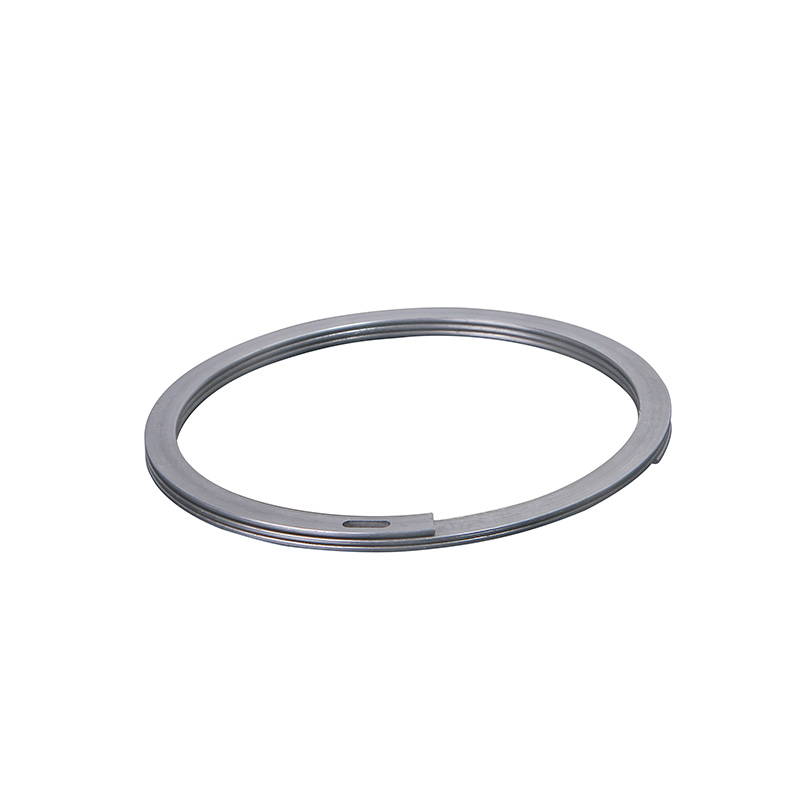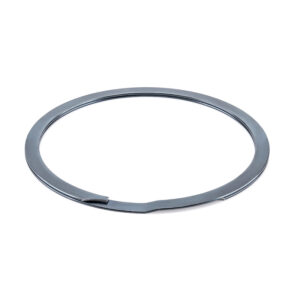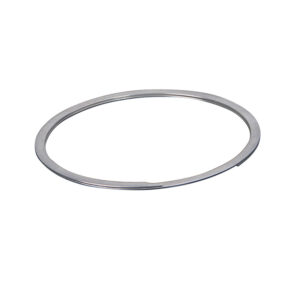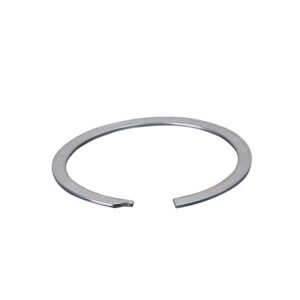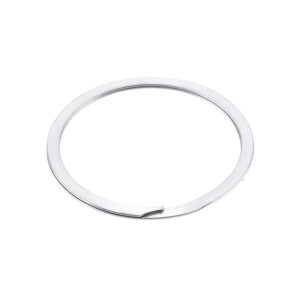SKU
b24900542eca
Categorias Anéis de retenção em espiral personalizados, Anel de Retenção Espiral
Descrição do produto
Anel de retenção espiral de 2 voltas balanceado interno
Descrição:
equilibrada equilibra estaticamente o anel de retenção. Uma série de ranhuras, opostas à extremidade da fenda, é responsável pelo material em falta na fenda. Esta caraterística é muito útil quando o equilíbrio do conjunto é crítico e é necessário reduzir a carga excêntrica.
Um anel de retenção em espiral equilibrado, também conhecido como anel de retenção equilibrado, é um tipo de anel de retenção em espiral que foi especificamente concebido para reduzir as forças centrífugas que são exercidas sobre o anel durante o funcionamento. Isto é conseguido através da criação de um design simétrico, ou "equilibrado", que distribui as forças uniformemente à volta do anel.
Os anéis de retenção em espiral equilibrada são normalmente utilizados em aplicações onde estão presentes velocidades elevadas ou cargas pesadas, como em motores, caixas de velocidades e outros sistemas mecânicos de elevado desempenho. Como são capazes de suportar estas forças melhor do que os anéis de retenção em espiral tradicionais, podem ajudar a prolongar a vida útil do sistema mecânico e reduzir o risco de falha.
Ao escolher um anel de retenção em espiral equilibrado, os factores a considerar incluem o diâmetro e a largura do anel, o material de que é feito, a capacidade de carga, a resistência à corrosão, a gama de temperaturas e a facilidade de instalação. Além disso, é importante ter em conta os requisitos específicos da aplicação, tais como a velocidade e as condições de carga que estarão presentes e as normas de conformidade da indústria.
Em geral, os anéis de retenção em espiral balanceados são mais caros que os convencionais, mas podem oferecer vantagens significativas em termos de desempenho e confiabilidade em determinadas aplicações.
ofício de processamento
Material adquirido - Produção - Primeiros ensaios - Enrolamento - Inspeção - Tratamento térmico - Limpeza - Tratamento de superfície - OQC - Embalagem - Expedição.
Especificação:
Sem folga; superfície de retenção 360 Economicamente produzido em aço inoxidável, uma vez que o processo de enrolamento não produz resíduos Sem custos de ferramentas em projectos personalizados Fácil instalação e remoção Utilizado no equilíbrio dinâmico é exigente.
| Material | Aço carbono (SWC), 65Mn, aço laminado a frio, aço inoxidável (SUS), cobre berílio, cobre fosforoso, latão, fio para música, fio para piano (SWP), 60Si2Mn, 55CrSi, etc. |
| Terminar | escurecimento, zincagem/níquel/cromo/prata/ouro, revestimento em pó, revestimento por pulverização, eletroforese, etc. |
| Certificação | ISO 9001:2008, TS 16949 e ISO 14001 |
| Grau de qualidade | Ótimo |
| Aplicativo | Eletrônico produtosBrinquedos para crianças, carrinhos de bebé, bicicletas, aparelhos de cozinha, máquinas fotográficas, impressoras, equipamento de escritório, equipamento de precisão e vários tipos de veículos |
| Tipo de Carga | Compressão, Torção, Extensão, Clipe, Pino |
| Notas | 1. Por favor, forneça-nos as suas especificações de molas; podemos fabricar molas com base nas suas necessidades. 2. É oferecido um desconto se a quantidade encomendada for elevada. |
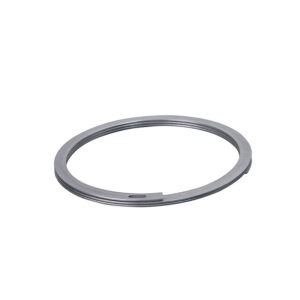
Características:
- Conjuntos diferentes podem atingir características de carga especiais.
- Alta capacidade de carga com pequena deflexão da mola.
- Melhor utilização do espaço em comparação com outras molas.
- As dimensões normalizadas podem reduzir os custos.
- Alta vida em fadiga.
- Excelente desempenho nos efeitos de amortecimento, especialmente quando empilhados.
Advafase:
- Vantagem da equipa de produção: Temos uma excelente equipa de tecnologia, e todos eles com experiência suficiente em I&D também produzem excelentes produtos de acordo com diferentes desenhos ou amostras de clientes;
- Vantagem de preço: Como fabricante, temos grandes vantagens em reduzir o custo do produto e também podemos dar mais descontos aos clientes de acordo com a quantidade do pedido. Os comerciantes não podem ser contactados.
- Personalizado Serviço OEM: O serviço personalizado está disponível. Podemos fabricar produtos de fixação padrão e não padrão de acordo com os seus desenhos. Fornecemos um serviço perfeito de pré-venda e pós-venda.
Classificação dos anéis de retenção
Anéis de retenção em espiral são diferentes dos tradicionais anéis de retenção por estampagem; os anéis de retenção em espiral adoptam um processo de fabrico por enrolamento para um diâmetro preciso. Têm uma secção transversal uniforme e estão isentos de rebarbas. Os anéis de retenção em espiral cumprem as especificações da indústria militar e aeroespacial e são utilizados em milhares de produtos mecânicos em todo o mundo.
Os anéis de retenção de encaixe comuns têm orelhas na sua estrutura, o que causa interferência com as peças internas. Os anéis de retenção elásticos em espiral feitos de aço inoxidável têm uma secção transversal consistente sem orelhas, pelo que não interferem com as peças correspondentes após a instalação, e o custo do anel de retenção é inferior ao dos anéis de retenção em espiral de cassete. A utilização do anel de retenção pode poupar o design do bloco de almofada, reduzir o tamanho do eixo, poupar materiais e tempo de processamento.
Um anel de retenção ondulado é um anel de retenção em espiral amovível com uma forma ondulada. Um anel de retenção ondulado pode substituir um anel de retenção e uma mola ondulada, que pode aplicar pressão no rolamento de esferas antecipadamente, e também é montado na ranhura como um anel de retenção em espiral normal.
O anel de retenção exterior do tipo offset de dupla volta é utilizado para substituir o bloco de almofadas. É utilizado para segurar a peça do bocal e facilitar a montagem. A largura dos anéis de retenção em espiral foi concebida para não haver interferência, e o seu diâmetro exterior é inferior ao diâmetro da raiz da rosca. No medidor de pressão, os anéis de retenção em espiral são instalados na ranhura rasa e produzem apenas uma pressão muito pequena na superfície do vidro. Este anel de retenção pode não só fixar o vidro de superfície, mas também não esmaga o vidro.
O anel de retenção forma paredes laterais em ambos os lados da polia síncrona. Este método elimina a parede lateral de pressão. Para facilitar a substituição da correia, o anel de retenção de um lado adopta o tipo fácil de remover. Os anéis de retenção em espiral ondulada são fáceis de satisfazer os requisitos de manutenção no local. Por exemplo, quando o anel de vedação do cilindro hidráulico precisa de ser reparado, os anéis de retenção em espiral podem ser rapidamente removidos com uma chave de fendas e facilmente reinstalados.
Características do anel de retenção em espiral equilibrado
As principais características dos anéis de retenção em espiral balanceados incluem:
- Design simétrico: O anel é projetado para ser simétrico, o que ajuda a distribuir as forças uniformemente ao redor do anel e reduz o risco de falha.
- Força centrífuga reduzida: O design simétrico do anel ajuda a reduzir as forças centrífugas que são exercidas no anel durante a operação, tornando-o mais adequado para aplicações de alta velocidade e alta carga.
- Melhor desempenho e fiabilidade: As forças centrífugas reduzidas e o design simétrico do anel podem ajudar a prolongar a vida útil do sistema mecânico e reduzir o risco de falha, resultando num melhor desempenho e fiabilidade.
- Aplicações de alta velocidade e alta carga: Os anéis de retenção espirais balanceados são normalmente usados em aplicações de alta velocidade e alta carga, como motores, caixas de engrenagens e outros sistemas mecânicos de alto desempenho.
- Material: Normalmente feito de aço mola, aço inoxidável ou outros materiais duráveis que sejam capazes de suportar as condições ambientais em que o anel será usado.
- Capacidade de carga: O anel deve ser capaz de suportar as forças que serão exercidas sobre ele durante a operação normal.
- Resistência à corrosão: Se o anel for usado em um ambiente onde a corrosão é uma preocupação, ele deve ser feito de um material resistente à ferrugem e outras formas de corrosão.
- Faixa de temperatura: O anel deve ser capaz de operar dentro da faixa de temperatura da aplicação.
- Conformidade: é importante verificar se o anel está em conformidade com quaisquer normas ou regulamentos relevantes do setor, como os estabelecidos pela ASTM, ASME ou ANSI.
- Equilíbrio: O anel é equilibrado, o que significa que o peso é distribuído uniformemente à volta do anel. Isto garante que o anel não vibrará excessivamente e afectará o desempenho da máquina.
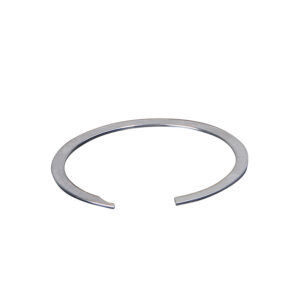
O mundo versátil dos anéis de retenção
1.1 O que são anéis de retenção?
Os anéis de retenção são fixadores circulares ou semi-circulares que se encaixam de forma segura numa ranhura ou canal num eixo ou no interior de um furo. Estes componentes de engenharia de precisão criam um ombro de retenção, impedindo o movimento axial e assegurando a estabilidade e a segurança gerais dos conjuntos mecânicos.
1.2 Nomenclatura e terminologia
Os anéis de retenção são conhecidos por vários nomes, tais como anéis de pressão, circlips ou C-rings. Estes termos são muitas vezes utilizados indistintamente, mas todos eles se referem ao mesmo conceito fundamental de um fixador de retenção.
Tipos de anéis de retenção
2.1 Anéis de retenção internos
Os anéis de retenção internos são concebidos para encaixar numa ranhura ou canal dentro de um furo, proporcionando retenção no interior do conjunto. São normalmente utilizados em aplicações em que as restrições de espaço impedem a utilização de anéis de retenção externos.
2.2 Anéis de retenção externos
Os anéis de retenção externos são concebidos para encaixar numa ranhura ou canal no exterior de um veio, proporcionando retenção a partir do exterior do conjunto. São normalmente utilizados quando os componentes a reter estão localizados no exterior do furo.
2.3 Anéis de retenção tradicionais
Os anéis de retenção tradicionais são tipicamente planos ou com arestas rectas, oferecendo um nível consistente de retenção. São amplamente utilizados em várias indústrias, desde a indústria automóvel à maquinaria industrial.
2.4 Anéis de retenção biselados
Os anéis de retenção biselados têm um ligeiro bisel ou cone num dos lados, permitindo uma retenção mais precisa. São frequentemente utilizados em aplicações em que a força de retenção tem de ser distribuída uniformemente.
2.5 E-Clips
Os clipes em E, também conhecidos como anéis em E ondulados ou curvos, têm uma forma ondulada que oferece um maior grau de flexibilidade e retenção em determinadas aplicações. Podem adaptar-se a pequenas variações nas dimensões das ranhuras.
Materiais do anel de retenção
3.1 Aço carbono
Os anéis de retenção em aço-carbono são económicos e oferecem uma boa resistência à corrosão. São normalmente utilizados em várias aplicações industriais, especialmente quando é possível efetuar uma manutenção frequente.
3.2 Aço inoxidável
Os anéis de retenção em aço inoxidável oferecem uma excelente resistência à corrosão, o que os torna ideais para aplicações em ambientes agressivos, como as indústrias marinha, química ou de processamento alimentar.
3.3 Cobre-berílio
Os anéis de retenção em cobre-berílio proporcionam uma força excecional, condutividade eléctrica e resistência à corrosão. São frequentemente utilizados em aplicações eléctricas e de alta temperatura.
3.4 Bronze fosforoso
Os anéis de retenção em bronze fosforoso são conhecidos pela sua elevada resistência ao desgaste. São normalmente utilizados em aplicações onde são necessárias montagens e desmontagens frequentes.
Quais são as principais diferenças entre os anéis de retenção internos e externos e quando é que cada tipo deve ser utilizado numa aplicação?
Os anéis de retenção internos e externos têm finalidades semelhantes, que consistem em fixar componentes num eixo ou no interior de um furo, mas têm características e aplicações distintas:
Anéis de retenção internos:
- Localização: Os anéis de retenção internos são concebidos para encaixar no interior de um furo ou caixa, criando um ressalto para evitar que os componentes se movam para fora ao longo do eixo.
- Instalação: São normalmente instalados numa ranhura de anel de retenção maquinada no interior de um furo ou caixa.
- Aplicações: Os anéis de retenção internos são normalmente utilizados em aplicações em que é mais prático ou necessário fixar componentes dentro de uma caixa, como em cilindros hidráulicos, caixas de rolamentos e alguns tipos de conjuntos de máquinas.
Anéis de retenção externos:
- Localização: Os anéis de retenção externos são concebidos para se adaptarem ao exterior de um eixo, impedindo que os componentes se afastem axialmente do eixo.
- Instalação: São instalados numa ranhura do anel de retenção no exterior do veio, que é normalmente maquinada na superfície do veio.
- Aplicações: Os anéis de retenção externos são amplamente utilizados em aplicações em que é necessário fixar componentes num eixo, como em eixos de automóveis, caixas de velocidades ou vários conjuntos de máquinas e equipamentos.
Quando utilizar cada tipo:
A escolha entre anéis de retenção internos e externos depende dos requisitos e restrições específicos da aplicação. Eis algumas considerações:
- Restrições de espaço: Se o espaço dentro de um furo for limitado, um anel de retenção interno pode ser a melhor escolha, uma vez que não aumenta o diâmetro do eixo. Por outro lado, se o espaço não for uma preocupação, podem ser utilizados anéis de retenção externos.
- Direção da carga: Considere a direção em que a carga ou força será aplicada. Se o componente precisar de resistir a forças axiais que o empurram para fora do eixo, é adequado um anel de retenção externo. Se a força vier do interior do furo e empurrar os componentes para fora, deve ser utilizado um anel de retenção interno.
- Acessibilidade: Considere a facilidade de acesso à área de instalação. Os anéis de retenção externos são geralmente mais fáceis de instalar e remover do que os internos, especialmente em aplicações com acesso limitado.
- Factores ambientais: Considere o ambiente em que os anéis de retenção serão utilizados. Os anéis de retenção externos podem ser mais adequados em ambientes com exposição a pó, humidade ou elementos corrosivos, uma vez que podem ser facilmente inspeccionados e substituídos, se necessário.
Em resumo, a escolha entre anéis de retenção internos e externos depende da conceção da aplicação específica e dos requisitos funcionais, incluindo espaço, direção da carga, acessibilidade e factores ambientais.
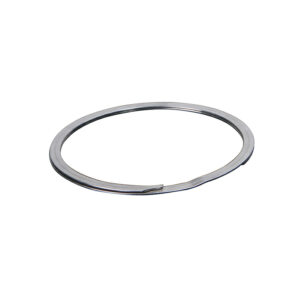
Como é que determino o tamanho correto de um anel de retenção para um eixo ou furo específico e que normas ou directrizes devo seguir para o dimensionamento?
Determinar o tamanho correto de um anel de retenção para um eixo ou furo específico é essencial para garantir a funcionalidade e segurança adequadas. Eis uma orientação geral sobre como dimensionar um anel de retenção:
1. Medir o veio ou o furo:
- Medir com precisão o diâmetro exterior do eixo (para os anéis de retenção externos) ou o diâmetro interior do furo (para os anéis de retenção internos), utilizando um paquímetro ou um micrómetro. Certifique-se de que as suas medições são precisas, uma vez que as imprecisões podem levar a um dimensionamento incorreto.
2. Determinar as dimensões da ranhura:
- Medir a profundidade e a largura da ranhura do anel de retenção no eixo ou no furo. As dimensões da ranhura devem ser compatíveis com as especificações do anel de retenção. Se a ranhura ainda não estiver presente, será necessário criar uma com base nas especificações do anel de retenção.
3. Verificação das normas:
- Procure normas ou directrizes da indústria que se possam aplicar à sua aplicação específica. As normas comuns para anéis de retenção incluem DIN (alemã), ANSI (americana) e JIS (japonesa). Estas normas fornecem informações sobre as dimensões e tolerâncias padrão das ranhuras.
4. Seleccione o tipo de anel de retenção:
- Determine se necessita de um anel de retenção interno ou externo, com base nos requisitos específicos e na conceção da sua aplicação. A escolha entre os dois tipos é fundamental.
5. Consultar os dados do fabricante:
- Consulte a documentação do fabricante, que deve especificar o(s) tamanho(s) recomendado(s) do anel de retenção para um determinado eixo ou diâmetro do furo e dimensões da ranhura. Os fabricantes fornecem frequentemente tabelas e directrizes de dimensionamento detalhadas.
6. Calcular o tamanho do anel:
- Utilizando as medidas e directrizes que reuniu, seleccione o tamanho do anel de retenção que corresponde ao diâmetro do eixo ou do furo e às dimensões da ranhura. Certifique-se de que tem em conta quaisquer folgas e tolerâncias necessárias, conforme especificado pelo fabricante ou pelas normas.
7. Verifique novamente a sua seleção:
- Confirme que o tamanho do anel de retenção selecionado é adequado, comparando-o com os requisitos da aplicação, as dimensões da ranhura e o diâmetro do eixo ou do furo. Certifique-se de que encaixa bem e não causa tensão excessiva nos componentes.
8. Efetuar uma montagem simulada:
- Antes de finalizar a sua escolha, considere a realização de uma montagem simulada com o anel de retenção selecionado para garantir que se encaixa e funciona corretamente. Isto pode ajudar a identificar quaisquer problemas potenciais antes da instalação final.
É importante notar que, em caso de dúvida ou quando se trata de aplicações críticas, é aconselhável consultar um fabricante de anéis de retenção ou um engenheiro com experiência na seleção de fixadores. Estes podem fornecer orientação especializada, tendo em conta factores como a seleção do material, a conceção da ranhura e os requisitos de carga. Os anéis de retenção corretamente dimensionados e instalados são cruciais para o funcionamento seguro e fiável do seu equipamento.
FAQs
P: O que é um anel de retenção?
Um anel de retenção, também conhecido como anel de pressão ou anel de retenção, é um elemento de fixação utilizado para fixar componentes num eixo ou no interior de um furo. Foi concebido para manter as peças no lugar, encaixando-as numa ranhura ou recesso, impedindo-as de se moverem axialmente.
P: Quais são os tipos mais comuns de anéis de retenção?
Existem dois tipos principais de anéis de retenção: internos e externos. Os anéis de retenção internos encaixam dentro de um furo ou caixa, enquanto os anéis de retenção externos encaixam à volta de um eixo. Estes podem ainda ser categorizados em vários estilos, incluindo anéis de pressão, anéis em E, anéis em C e muito mais.
P: De que materiais são normalmente feitos os anéis de retenção?
Os anéis de retenção são normalmente fabricados a partir de materiais como aço para molas, aço carbono, aço inoxidável e, por vezes, plásticos. A escolha do material depende dos requisitos específicos da aplicação, incluindo factores como a resistência à corrosão, a capacidade de suporte de carga e as condições ambientais.
P: Como é que os anéis de retenção são instalados e removidos?
Os anéis de retenção são normalmente instalados e removidos utilizando ferramentas especializadas, tais como alicates de anéis de retenção. Para instalar um anel de retenção, o anel é comprimido para encaixar na ranhura e, quando libertado, expande-se para fixar os componentes. Para remover um anel de retenção, este é comprimido com um alicate ou uma ferramenta semelhante para permitir uma extração fácil.
P: Quais são algumas das aplicações comuns para anéis de retenção?
Os anéis de retenção são utilizados em várias aplicações em que os componentes têm de ser fixados num eixo ou no interior de um furo. Algumas aplicações comuns incluem transmissões automóveis, caixas de velocidades, maquinaria industrial, aparelhos e muitos outros sistemas mecânicos e de engenharia.
P: Qual é o objetivo das ranhuras ou reentrâncias em que são instalados os anéis de retenção?
As ranhuras ou recessos, conhecidos como ranhuras do anel de retenção, são características maquinadas no eixo ou furo onde o anel de retenção é instalado. Proporcionam uma localização segura para o anel encaixar, impedindo o movimento axial dos componentes que estão a ser retidos.
P: Os anéis de retenção podem ser reutilizados?
Em muitos casos, os anéis de retenção podem ser reutilizados, desde que não sejam danificados durante a remoção. No entanto, é essencial inspeccioná-los para detetar sinais de desgaste, deformação ou outros problemas que possam comprometer a sua eficácia. Em caso de dúvida, recomenda-se geralmente a sua substituição por anéis novos, por razões de segurança e fiabilidade.
P: Existem diferentes padrões de tamanho para os anéis de retenção?
Sim, existem várias normas internacionais e convenções de dimensionamento para anéis de retenção, incluindo DIN (alemão), ANSI (americano) e JIS (japonês). Estas normas definem as dimensões e especificações dos anéis de retenção para garantir a compatibilidade com diferentes aplicações e componentes.
P: Os anéis de retenção podem falhar e quais são as consequências dessa falha?
Os anéis de retenção podem falhar se estiverem danificados, gastos ou não forem instalados corretamente. As consequências da falha podem incluir componentes que se soltam, levando ao mau funcionamento da máquina, danos ou mesmo riscos de segurança. A inspeção e manutenção regulares são essenciais para evitar tais falhas.
P: Existem alternativas aos anéis de retenção para fixar componentes em veios ou em furos?
Sim, existem métodos alternativos para fixar componentes, incluindo parafusos de ajuste, pinos, ranhuras e roscas. A escolha do método depende da aplicação específica e dos requisitos de segurança, facilidade de montagem e manutenção.

